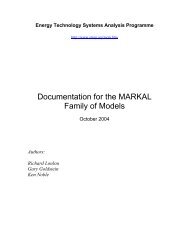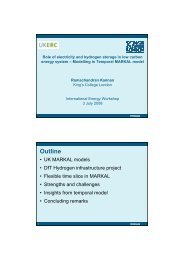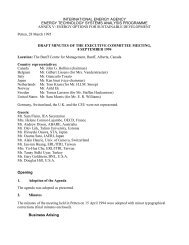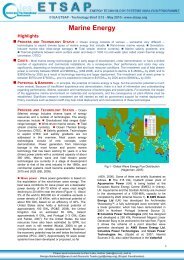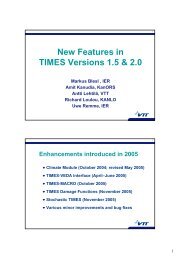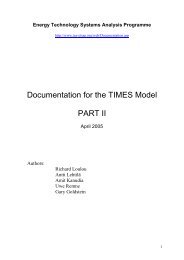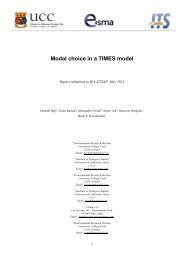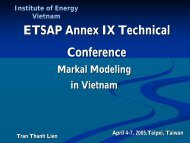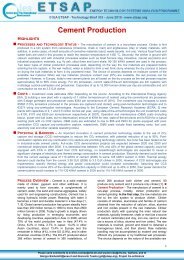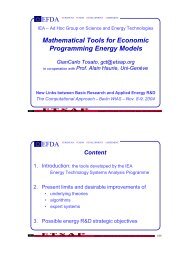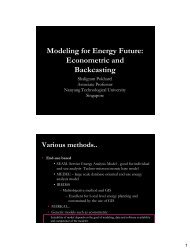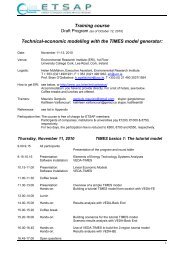Energy Technology Systems Analysis Programme - iea-etsap
Energy Technology Systems Analysis Programme - iea-etsap
Energy Technology Systems Analysis Programme - iea-etsap
You also want an ePaper? Increase the reach of your titles
YUMPU automatically turns print PDFs into web optimized ePapers that Google loves.
Figure 1: ETSAP tools and typical applications<br />
[Acronyms: MARKAL = MARKet Allocation; TIMES = The Integrated MARKAL - EFOM System; LP = Linear<br />
Programming; NLP = Non Linear Programming; VEDA = VErsatile Data Analyst; RD&D = Research,<br />
Development & Deployment]<br />
simultaneously, stepping through<br />
one period at a time to solve for<br />
the next n-periods; the 1st period<br />
in each solve is then fixed prior to<br />
stepping forward.<br />
1.2. Major enhancements that have<br />
been added to the MARKAL model to<br />
meet the needs of the EIA-SAGE<br />
model include:<br />
• The ability to run MARKAL in a<br />
time-stepped manner, meaning<br />
investment decisions are made<br />
in each period without knowledge<br />
of future events (often referred to<br />
as myopic or without foresight),<br />
whereas standard MARKAL is run<br />
in a clairvoyant manner; and<br />
• The initial development and<br />
subsequent refinement of the<br />
SAGE MarKeT SHaRe (MKTSHR)<br />
algorithm. The basis of this facility<br />
is to identify market segments or<br />
“groups of competing<br />
technologies” (e.g., all alternative<br />
fueled passenger vehicles), then<br />
accumulate the level of all the<br />
technologies in the market<br />
segment and redistribute to each<br />
technology in the group according<br />
to weighted shares as the relative<br />
cost.<br />
1.3. Major enhancements that have<br />
been added to the MARKAL model to<br />
meet the needs of the US Environment<br />
Protection Agency include:<br />
• The development of a Goal<br />
Programming formulation that<br />
permits the user to explore the<br />
trade-off between conflicting<br />
goals (e.g., least-cost and air<br />
quality) by assigning preferences<br />
to the various objectives being<br />
considered; and<br />
• The introduction of flexible timeslicing<br />
and thereby the removal<br />
of a long-standing MARKAL<br />
restriction that imposed a fixed<br />
segmentation of the electricity<br />
load curve by dividing the annual<br />
demand for and production of<br />
electricity into six distinct timeslices<br />
(3 seasons x 2 diurnal<br />
divisions), and three seasonal<br />
time-slices for heat. With flexible<br />
time-slicing, the user is able to<br />
control the number of seasons<br />
and the number of diurnal<br />
divisions.<br />
1.4. Other significant enhancements<br />
that have been added to MARKAL<br />
over the past several years include:<br />
• The development of a facility to<br />
model Lumpy Investment. This<br />
facility permits more<br />
sophisticated modeling in<br />
respect of lumpy investments<br />
(such as the construction of gas<br />
pipelines) by using mixed integer<br />
programming (MIP) techniques to<br />
model the all-or-nothing building<br />
of new capacity;<br />
• The development of a new<br />
Benefit/Cost report employing a<br />
new GAMS UnitB/C utility;<br />
• The development of a “RAT_FLO”<br />
facility that enables the user to<br />
associate commodity flows in/out<br />
of technologies with ADRATIO<br />
constraints; and<br />
• The provision of improved<br />
2



